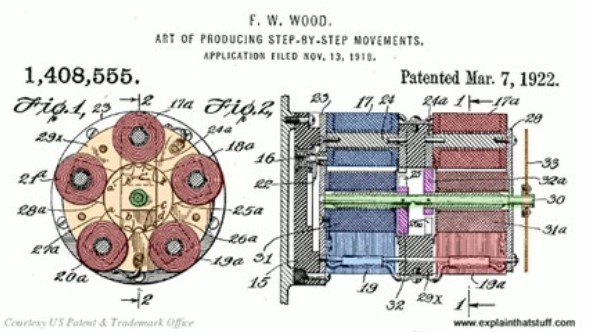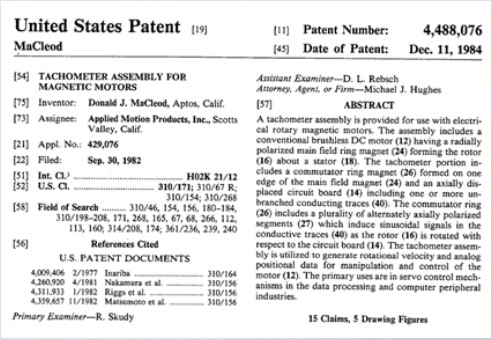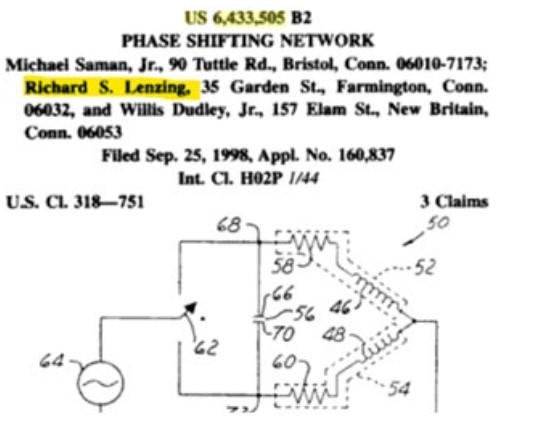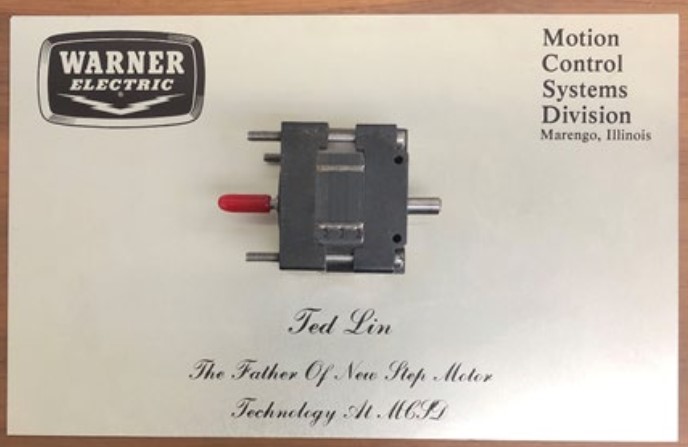Moved forward 100 years - Early history of stepping motor
By Lin Engineering William Chen
Stepping motor was invented ten decades ago. Now it is the time to celebrate the 100 years' anniversary of its invention. Early of last century, there were three important invention patents started the history of stepping motor. Frank W. Wood, a U.S inventor, filed the first patent at 1918. Here is the 1918-filed design (officially patented on March 7, 1922), titled "Art of producing step-by-step movements," which uses an outer ring of five magnets (energized in various combinations) to make a pair of inner magnets and a shaft rotate. In Wood's own words, his gadget produces" step by-step movements to a rotable element... provided by the resultant action of a plurality of magnetic circuits." The 2nd one was the invention of salient tooth structure on both the stator and rotor of the VR stepping motor, for which C.L Walker was awarded a British patent in 1919; The third invention is of the sandwich structure for producing higher power density, by C.B Chicken and J.H Train, the U.S patent had been approved in 1920.  Frank W. Wood Patent #1,408,555 The system was developed in the 1930s as a means of controlling gun turrets and cannons on large ships and then in early 1940s U.S Navy applied the same systems. Such a similar systems remain in use today. We could image such a system was involved World War II against Japan, then decades later, Japan became the leading country of stepping motor manufacturing. HB stepping motor starts at 1952. There were three companies had their contribution in realization of HB stepping motor. General Electric; Superior Electric and Sigma Instruments. General Electric had developed an ac synchronous inductor motor for the adjustable transformer and rheostat that Superior Electric manufactures. This motor was designed to operate with a 60-Hz, 115-Vac signal and generate smooth continuous motion equivalent to the movement of an analog clock’s second hand. In 1961, Snowden and Madsen of Superior Electric Co. announced a new rendition of the synchronous inductor motor which would become famous by another name, the hybrid step motor. Within two years' hybrid step motor sales eclipsed that of ac synchronous inductor motors. The hybrid step motor drive scheme in 1961 also used a bifilar winding driving the two-phase winding halves A1, A2, B1, B2. The power supply current was in a single direction or in a unipolar excitation scheme. Unipolar-based drive circuits remained popular throughout the 1960s and 1970s. Rich Lenzing who has been working at Moons USA since 2008, had been working in Superior Electric for decades. He gained eight invention patents in Superior Electric since 1982. Rich is not just one of the historic attendees and witnesses, but contributed his talent in HB stepping motor's improvement and upgrade. Below is one of these patents. VR stepping motor, as alternative of servo solution, had been the main stepping motor products in the market until early 1960s, when PM stepping motor "stepped in" through the cost advantage. PM stepping motor has been overcoming VR stepping motor market gradually from 1960s to late 1970s. From 1980s, HB stepping motor started his main role mission in this industry led by the demanding in application of computer peripherals. A major technological breakthrough for motors was the development of the rare earth cobalt magnet family by Wright-Patterson Research Center in Dayton, Ohio,USA in the 1960s.The samarium cobalt family of permanent magnets possessed high flux generating capability along with a high coercive force. Neodymium (atomic weight 60) that discovered by an Austrian scientist named Baron Carl Auer von Welsbach, in 1885, became a key role in stepping motor industry. Later, a neodymium magnet (also known as NdFeB, NIB, or Neo magnet), Developed in 1982 by General Motors and Sumitomo Special Metals.
Frank W. Wood Patent #1,408,555 The system was developed in the 1930s as a means of controlling gun turrets and cannons on large ships and then in early 1940s U.S Navy applied the same systems. Such a similar systems remain in use today. We could image such a system was involved World War II against Japan, then decades later, Japan became the leading country of stepping motor manufacturing. HB stepping motor starts at 1952. There were three companies had their contribution in realization of HB stepping motor. General Electric; Superior Electric and Sigma Instruments. General Electric had developed an ac synchronous inductor motor for the adjustable transformer and rheostat that Superior Electric manufactures. This motor was designed to operate with a 60-Hz, 115-Vac signal and generate smooth continuous motion equivalent to the movement of an analog clock’s second hand. In 1961, Snowden and Madsen of Superior Electric Co. announced a new rendition of the synchronous inductor motor which would become famous by another name, the hybrid step motor. Within two years' hybrid step motor sales eclipsed that of ac synchronous inductor motors. The hybrid step motor drive scheme in 1961 also used a bifilar winding driving the two-phase winding halves A1, A2, B1, B2. The power supply current was in a single direction or in a unipolar excitation scheme. Unipolar-based drive circuits remained popular throughout the 1960s and 1970s. Rich Lenzing who has been working at Moons USA since 2008, had been working in Superior Electric for decades. He gained eight invention patents in Superior Electric since 1982. Rich is not just one of the historic attendees and witnesses, but contributed his talent in HB stepping motor's improvement and upgrade. Below is one of these patents. VR stepping motor, as alternative of servo solution, had been the main stepping motor products in the market until early 1960s, when PM stepping motor "stepped in" through the cost advantage. PM stepping motor has been overcoming VR stepping motor market gradually from 1960s to late 1970s. From 1980s, HB stepping motor started his main role mission in this industry led by the demanding in application of computer peripherals. A major technological breakthrough for motors was the development of the rare earth cobalt magnet family by Wright-Patterson Research Center in Dayton, Ohio,USA in the 1960s.The samarium cobalt family of permanent magnets possessed high flux generating capability along with a high coercive force. Neodymium (atomic weight 60) that discovered by an Austrian scientist named Baron Carl Auer von Welsbach, in 1885, became a key role in stepping motor industry. Later, a neodymium magnet (also known as NdFeB, NIB, or Neo magnet), Developed in 1982 by General Motors and Sumitomo Special Metals.  The cost of Samarium Cobalt (SmCo) developed earlier was too high, and there was a need to find an economic magnet, which lead to the discovery of neodymium magnet. Sumitomo Special Metals, General Motors Corporation, and The China Academy of Sciences simultaneously formulated the neodymium magnet compound, in 1982.
The cost of Samarium Cobalt (SmCo) developed earlier was too high, and there was a need to find an economic magnet, which lead to the discovery of neodymium magnet. Sumitomo Special Metals, General Motors Corporation, and The China Academy of Sciences simultaneously formulated the neodymium magnet compound, in 1982.  On the other hand, from the aspect of the drive circuit, the development of stepper motor was closely subject to the development of the transistor semiconductor device. In 1950 diode semiconductor came out, and then MOS semiconductor in 1964. IC (integrated circuit) appeared in 1965, and LSI has been used in 1967. Because of the low cost and high reliability of logic digital circuits, application of stepper motors has been increasing dramatically. Japanese companies also involved and contributed their efforts in early age of stepping motor history. Till today, Japan still a nation with capable production of stepping motor design and manufacturing. At the year of 1960, Fujitsu developed their VR stepping motors for lather machine application. At same year, Sanyo Denki, a company make motor and generator since 1932 for telecommunication, also become a new player of VR stepping motor. Then in 1968, Sanyo Denki started their HB stepping motors for commercial market. At 1970, Sanyo Denki received their first order from IBM, which starts the history of Japanese stepping motor serves computer industry. As a result of stepping motor has been applied to more industries and applications, International Society of Stepper Motors was founded in 1970 and held its first IMCSD( Incremental Motion Control Systems and Devices) at Illinois University in the United States. The two companies Warner Electric and Westool coorganized the conference. Mr. Lin, currently titled as Moons Corporate VP, the founder and former President of Lin Engineering, was working in Warner Electric as the design leader of stepping motor, awarded as "The Father of New Step Motor Technology at MCSD", while MCSD is a division of Warner Electric in Marengo, Illinois, USA.
On the other hand, from the aspect of the drive circuit, the development of stepper motor was closely subject to the development of the transistor semiconductor device. In 1950 diode semiconductor came out, and then MOS semiconductor in 1964. IC (integrated circuit) appeared in 1965, and LSI has been used in 1967. Because of the low cost and high reliability of logic digital circuits, application of stepper motors has been increasing dramatically. Japanese companies also involved and contributed their efforts in early age of stepping motor history. Till today, Japan still a nation with capable production of stepping motor design and manufacturing. At the year of 1960, Fujitsu developed their VR stepping motors for lather machine application. At same year, Sanyo Denki, a company make motor and generator since 1932 for telecommunication, also become a new player of VR stepping motor. Then in 1968, Sanyo Denki started their HB stepping motors for commercial market. At 1970, Sanyo Denki received their first order from IBM, which starts the history of Japanese stepping motor serves computer industry. As a result of stepping motor has been applied to more industries and applications, International Society of Stepper Motors was founded in 1970 and held its first IMCSD( Incremental Motion Control Systems and Devices) at Illinois University in the United States. The two companies Warner Electric and Westool coorganized the conference. Mr. Lin, currently titled as Moons Corporate VP, the founder and former President of Lin Engineering, was working in Warner Electric as the design leader of stepping motor, awarded as "The Father of New Step Motor Technology at MCSD", while MCSD is a division of Warner Electric in Marengo, Illinois, USA.  Ted Lin awarded as "The Father of New Step Motor Technology at MCSD", 1983 After the first IMCSD conference, there are three conferences on stepping motor and systems held at University of Leeds (UK) in 1974,1976 and 1979. Don MacLeod attend the conference in 1979 while he was studying in Leeds for his PHD degree. The 1979 conference was an opportunity for Don first time meeting Applied Motion Products (AMP), then Join AMP and now he holds president position of AMP. Later 1974s', 2-phase stepping motor widely applied in FDD (Floppy Disk Drive) and HD (Hard Disk Driver). Don MacLeod designed the first stepping motor for HD application and wining the business against German competitor. One of patent that Don awarded associated with stepping motor design shows below: Since 1980s and 1990s, stepping motor starts a very new chapter of its history; Shanghai Moons Electric Co Ltd. Has been involving the business, and become a part of the new history as a leading developer, designer and manufacture.
Ted Lin awarded as "The Father of New Step Motor Technology at MCSD", 1983 After the first IMCSD conference, there are three conferences on stepping motor and systems held at University of Leeds (UK) in 1974,1976 and 1979. Don MacLeod attend the conference in 1979 while he was studying in Leeds for his PHD degree. The 1979 conference was an opportunity for Don first time meeting Applied Motion Products (AMP), then Join AMP and now he holds president position of AMP. Later 1974s', 2-phase stepping motor widely applied in FDD (Floppy Disk Drive) and HD (Hard Disk Driver). Don MacLeod designed the first stepping motor for HD application and wining the business against German competitor. One of patent that Don awarded associated with stepping motor design shows below: Since 1980s and 1990s, stepping motor starts a very new chapter of its history; Shanghai Moons Electric Co Ltd. Has been involving the business, and become a part of the new history as a leading developer, designer and manufacture.
 Frank W. Wood Patent #1,408,555 The system was developed in the 1930s as a means of controlling gun turrets and cannons on large ships and then in early 1940s U.S Navy applied the same systems. Such a similar systems remain in use today. We could image such a system was involved World War II against Japan, then decades later, Japan became the leading country of stepping motor manufacturing. HB stepping motor starts at 1952. There were three companies had their contribution in realization of HB stepping motor. General Electric; Superior Electric and Sigma Instruments. General Electric had developed an ac synchronous inductor motor for the adjustable transformer and rheostat that Superior Electric manufactures. This motor was designed to operate with a 60-Hz, 115-Vac signal and generate smooth continuous motion equivalent to the movement of an analog clock’s second hand. In 1961, Snowden and Madsen of Superior Electric Co. announced a new rendition of the synchronous inductor motor which would become famous by another name, the hybrid step motor. Within two years' hybrid step motor sales eclipsed that of ac synchronous inductor motors. The hybrid step motor drive scheme in 1961 also used a bifilar winding driving the two-phase winding halves A1, A2, B1, B2. The power supply current was in a single direction or in a unipolar excitation scheme. Unipolar-based drive circuits remained popular throughout the 1960s and 1970s. Rich Lenzing who has been working at Moons USA since 2008, had been working in Superior Electric for decades. He gained eight invention patents in Superior Electric since 1982. Rich is not just one of the historic attendees and witnesses, but contributed his talent in HB stepping motor's improvement and upgrade. Below is one of these patents. VR stepping motor, as alternative of servo solution, had been the main stepping motor products in the market until early 1960s, when PM stepping motor "stepped in" through the cost advantage. PM stepping motor has been overcoming VR stepping motor market gradually from 1960s to late 1970s. From 1980s, HB stepping motor started his main role mission in this industry led by the demanding in application of computer peripherals. A major technological breakthrough for motors was the development of the rare earth cobalt magnet family by Wright-Patterson Research Center in Dayton, Ohio,USA in the 1960s.The samarium cobalt family of permanent magnets possessed high flux generating capability along with a high coercive force. Neodymium (atomic weight 60) that discovered by an Austrian scientist named Baron Carl Auer von Welsbach, in 1885, became a key role in stepping motor industry. Later, a neodymium magnet (also known as NdFeB, NIB, or Neo magnet), Developed in 1982 by General Motors and Sumitomo Special Metals.
Frank W. Wood Patent #1,408,555 The system was developed in the 1930s as a means of controlling gun turrets and cannons on large ships and then in early 1940s U.S Navy applied the same systems. Such a similar systems remain in use today. We could image such a system was involved World War II against Japan, then decades later, Japan became the leading country of stepping motor manufacturing. HB stepping motor starts at 1952. There were three companies had their contribution in realization of HB stepping motor. General Electric; Superior Electric and Sigma Instruments. General Electric had developed an ac synchronous inductor motor for the adjustable transformer and rheostat that Superior Electric manufactures. This motor was designed to operate with a 60-Hz, 115-Vac signal and generate smooth continuous motion equivalent to the movement of an analog clock’s second hand. In 1961, Snowden and Madsen of Superior Electric Co. announced a new rendition of the synchronous inductor motor which would become famous by another name, the hybrid step motor. Within two years' hybrid step motor sales eclipsed that of ac synchronous inductor motors. The hybrid step motor drive scheme in 1961 also used a bifilar winding driving the two-phase winding halves A1, A2, B1, B2. The power supply current was in a single direction or in a unipolar excitation scheme. Unipolar-based drive circuits remained popular throughout the 1960s and 1970s. Rich Lenzing who has been working at Moons USA since 2008, had been working in Superior Electric for decades. He gained eight invention patents in Superior Electric since 1982. Rich is not just one of the historic attendees and witnesses, but contributed his talent in HB stepping motor's improvement and upgrade. Below is one of these patents. VR stepping motor, as alternative of servo solution, had been the main stepping motor products in the market until early 1960s, when PM stepping motor "stepped in" through the cost advantage. PM stepping motor has been overcoming VR stepping motor market gradually from 1960s to late 1970s. From 1980s, HB stepping motor started his main role mission in this industry led by the demanding in application of computer peripherals. A major technological breakthrough for motors was the development of the rare earth cobalt magnet family by Wright-Patterson Research Center in Dayton, Ohio,USA in the 1960s.The samarium cobalt family of permanent magnets possessed high flux generating capability along with a high coercive force. Neodymium (atomic weight 60) that discovered by an Austrian scientist named Baron Carl Auer von Welsbach, in 1885, became a key role in stepping motor industry. Later, a neodymium magnet (also known as NdFeB, NIB, or Neo magnet), Developed in 1982 by General Motors and Sumitomo Special Metals.  The cost of Samarium Cobalt (SmCo) developed earlier was too high, and there was a need to find an economic magnet, which lead to the discovery of neodymium magnet. Sumitomo Special Metals, General Motors Corporation, and The China Academy of Sciences simultaneously formulated the neodymium magnet compound, in 1982.
The cost of Samarium Cobalt (SmCo) developed earlier was too high, and there was a need to find an economic magnet, which lead to the discovery of neodymium magnet. Sumitomo Special Metals, General Motors Corporation, and The China Academy of Sciences simultaneously formulated the neodymium magnet compound, in 1982.  On the other hand, from the aspect of the drive circuit, the development of stepper motor was closely subject to the development of the transistor semiconductor device. In 1950 diode semiconductor came out, and then MOS semiconductor in 1964. IC (integrated circuit) appeared in 1965, and LSI has been used in 1967. Because of the low cost and high reliability of logic digital circuits, application of stepper motors has been increasing dramatically. Japanese companies also involved and contributed their efforts in early age of stepping motor history. Till today, Japan still a nation with capable production of stepping motor design and manufacturing. At the year of 1960, Fujitsu developed their VR stepping motors for lather machine application. At same year, Sanyo Denki, a company make motor and generator since 1932 for telecommunication, also become a new player of VR stepping motor. Then in 1968, Sanyo Denki started their HB stepping motors for commercial market. At 1970, Sanyo Denki received their first order from IBM, which starts the history of Japanese stepping motor serves computer industry. As a result of stepping motor has been applied to more industries and applications, International Society of Stepper Motors was founded in 1970 and held its first IMCSD( Incremental Motion Control Systems and Devices) at Illinois University in the United States. The two companies Warner Electric and Westool coorganized the conference. Mr. Lin, currently titled as Moons Corporate VP, the founder and former President of Lin Engineering, was working in Warner Electric as the design leader of stepping motor, awarded as "The Father of New Step Motor Technology at MCSD", while MCSD is a division of Warner Electric in Marengo, Illinois, USA.
On the other hand, from the aspect of the drive circuit, the development of stepper motor was closely subject to the development of the transistor semiconductor device. In 1950 diode semiconductor came out, and then MOS semiconductor in 1964. IC (integrated circuit) appeared in 1965, and LSI has been used in 1967. Because of the low cost and high reliability of logic digital circuits, application of stepper motors has been increasing dramatically. Japanese companies also involved and contributed their efforts in early age of stepping motor history. Till today, Japan still a nation with capable production of stepping motor design and manufacturing. At the year of 1960, Fujitsu developed their VR stepping motors for lather machine application. At same year, Sanyo Denki, a company make motor and generator since 1932 for telecommunication, also become a new player of VR stepping motor. Then in 1968, Sanyo Denki started their HB stepping motors for commercial market. At 1970, Sanyo Denki received their first order from IBM, which starts the history of Japanese stepping motor serves computer industry. As a result of stepping motor has been applied to more industries and applications, International Society of Stepper Motors was founded in 1970 and held its first IMCSD( Incremental Motion Control Systems and Devices) at Illinois University in the United States. The two companies Warner Electric and Westool coorganized the conference. Mr. Lin, currently titled as Moons Corporate VP, the founder and former President of Lin Engineering, was working in Warner Electric as the design leader of stepping motor, awarded as "The Father of New Step Motor Technology at MCSD", while MCSD is a division of Warner Electric in Marengo, Illinois, USA.  Ted Lin awarded as "The Father of New Step Motor Technology at MCSD", 1983 After the first IMCSD conference, there are three conferences on stepping motor and systems held at University of Leeds (UK) in 1974,1976 and 1979. Don MacLeod attend the conference in 1979 while he was studying in Leeds for his PHD degree. The 1979 conference was an opportunity for Don first time meeting Applied Motion Products (AMP), then Join AMP and now he holds president position of AMP. Later 1974s', 2-phase stepping motor widely applied in FDD (Floppy Disk Drive) and HD (Hard Disk Driver). Don MacLeod designed the first stepping motor for HD application and wining the business against German competitor. One of patent that Don awarded associated with stepping motor design shows below: Since 1980s and 1990s, stepping motor starts a very new chapter of its history; Shanghai Moons Electric Co Ltd. Has been involving the business, and become a part of the new history as a leading developer, designer and manufacture.
Ted Lin awarded as "The Father of New Step Motor Technology at MCSD", 1983 After the first IMCSD conference, there are three conferences on stepping motor and systems held at University of Leeds (UK) in 1974,1976 and 1979. Don MacLeod attend the conference in 1979 while he was studying in Leeds for his PHD degree. The 1979 conference was an opportunity for Don first time meeting Applied Motion Products (AMP), then Join AMP and now he holds president position of AMP. Later 1974s', 2-phase stepping motor widely applied in FDD (Floppy Disk Drive) and HD (Hard Disk Driver). Don MacLeod designed the first stepping motor for HD application and wining the business against German competitor. One of patent that Don awarded associated with stepping motor design shows below: Since 1980s and 1990s, stepping motor starts a very new chapter of its history; Shanghai Moons Electric Co Ltd. Has been involving the business, and become a part of the new history as a leading developer, designer and manufacture.